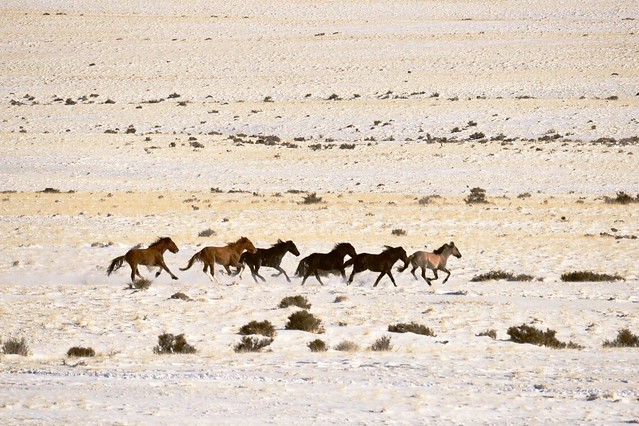
Sulphur Herd Management Area
Overview
In the mountain peaks and sloping lowlands of western Utah roams a nationally recognized population of wild horses with a Utah heritage much older than most of ours. Many of these horses draw their bloodlines from the Colonial Spanish Horse, the first horses brought to America by the Spanish explorers in the 1500s. Through time, the Sulphur Herd bred with escaped ranch livestock, but some still hold many of the Colonial Spanish Horse traits. These traits include colors that are dun and grulla, a gray or mouse color. Their ears can curve in like a bird's beak, with fawn colored insides rimmed in black. They may have a dorsal stripe down their back, bi-colored manes and tails, and striped legs. Some may even have some facial cob webbing or a mask on their face. The horses have a short back, because they may have only five lumbar vertebrae instead of six. There are only a few other herds of wild horses in the United States that exhibit these same characteristics.
Location and Size
The Sulphur Herd Management Area (HMA) is located in western Iron, Beaver, and Millard counties, Utah, approximately 50 miles west of Minersville in the Indian Peak and Mountain Home mountain ranges. The elevation ranges from 9,790 feet on top of Indian Peak to 6,000 feet on the valley floors. The HMA contains 230,157 acres of BLM land and 35,554 acres of federal, state, and privately owned land for a total of 265,711 acres.
Topography/Vegetation
The Sulphur HMA supports multiple vegetation types including Aspen, Mountain Fir, Spruce-Fir, Mountain Shrub, Pinyon-Juniper (PJ), sagebrush, grasslands, and salt desert shrub. The PJ woodland type dominates the HMA and is very dense with minimal understory forage. Open areas outside the PJ canopy are dominated by big sagebrush with Indian ricegrass, wheatgrass, bluegrass, and squirreltail grass as the primary forage species. Available water within the HMA is the limiting factor regarding these horse populations. Water is limited to isolated springs and built structures that supply water to permitted livestock, wildlife, and wild horses. Several springs primarily used by wild horses were dry during the summers of 2000-2004, 2007-2008, and 2012-2015, forcing animals onto winter ranges and into areas outside of the HMA traditionally unoccupied by horses. Most water sources produced less than average levels for the summer, forcing wild horses to use winter ranges throughout the summer. The appropriate management level for this HMA is 165-250.
Wildlife
Big game species that occur in the Sulphur HMA include mule deer, Rocky Mountain elk, and pronghorn. All three species are year-long residents. Competition for forage between big game species and wild horses is greatest during the spring and summer months when mule deer, elk and pronghorn are feeding primarily on grasses and forbs. Additionally, forb consumption is crucial during the early spring months for does to maintain a healthy body condition while meeting the nutrient requirements of nursing fawns. Competition is reduced in fall and winter when mule deer and pronghorn shift their diets to browse (i.e. bitterbrush, sagebrush) species. Typically, elk move to wintering areas throughout the Pine and Hamlin Valleys. During periods of drought, competition between wildlife and wild horses increases dramatically when less forage is available.
Viewing Opportunities
The Needle Range is characterized by steep slopes and narrow ridges. Access to the ridges and surrounding areas is good, provided you are driving a vehicle capable of traversing rough, back country roads. You will find most of the horses in the Mountain Home and Indian Peak portions of the range. An extensive dirt-road system provides access throughout the entire area for those properly equipped. Typically, roads wander through sagebrush flats and forests of PJ. The high country of Mountain Home Peak is a particularly pleasant destination, providing outstanding views of Hamlin Valley and Great Basin National Park. The best access to the road network in the herd area is Utah Highway 21. Approximately 45 miles west of Milford on U-21, look for a BLM sign marked Pots-Sum-Pa spring. Turn south on this road to enter the northeastern portion of the Sulphur HMA.


